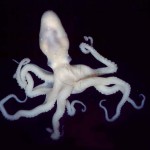 Increased levels of carbon dioxide in the atmosphere leads to more dissolved CO2 in the world’s oceans. In turn this will increase the hydrogen ion concentration in seawater, and lower pH from pre-industrial levels (8.179) to present day levels (8.104) in a process known as “ocean acidification”. Note that even projected pH levels of 7.824 in 2050 are still above neutral. Regardless, many scientists are concerned that calcifying marine organisms like corals, mollusks, echinoderms and coccolithophores will be vulnerable to dissolution under the projected ‘less alkaline’ regime.
Increased levels of carbon dioxide in the atmosphere leads to more dissolved CO2 in the world’s oceans. In turn this will increase the hydrogen ion concentration in seawater, and lower pH from pre-industrial levels (8.179) to present day levels (8.104) in a process known as “ocean acidification”. Note that even projected pH levels of 7.824 in 2050 are still above neutral. Regardless, many scientists are concerned that calcifying marine organisms like corals, mollusks, echinoderms and coccolithophores will be vulnerable to dissolution under the projected ‘less alkaline’ regime.
A new study published in Geochemistry, Geophysics, and Geosystems (G Cubed) by French researchers Luc Beaufort, Ian Probert, and Noelle Bouchet uses a new method to estimate the effect of dissolution on calcium carbonate plates (coccoliths) secreted by Emiliana huxleyi coccolithophores. E. huxleyi is a cosmopolitan single celled algae responsible for a good deal of global primary production. The researchers conducted two acidification experiments, using cultured and fossil coccoliths.The results indicate that acidification does not change significantly the weight and size of coccoliths.





